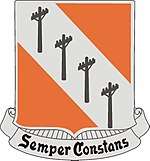51st Expeditionary Signal Battalion
| 51st Signal Battalion | |
|---|---|
|
Distinctive Unit Insignia | |
| Country | United States of America |
| Branch | Regular Army |
| Type | Signal |
| Size | Battalion |
| Part of | 35th Signal Brigade |
| Motto(s) | “Semper Constans” |
| U.S. Army Signal Battalions | |
|---|---|
| Previous | Next |
| 50th Expeditionary Signal Battalion | 53rd Signal Battalion |
The 51st Signal Battalion is a United States Army unit which is part of the 35th Signal Brigade located at Joint Base Lewis-McChord (JBLM; formerly the separate Fort Lewis and McChord AFB), Washington. Its mission is to rapidly deploy worldwide to engineer, install, operate, maintain, and defend the LandWarNet in support of full spectrum operations.[1][2] The battalion deployed to Iraq in 2003-2004 and in 2008-2009[3] and sent elements to Afghanistan in 2010 and 2011. The unit was deployed as of January 2015.[4]
History
The 51st Signal Battalion was constituted on July 1, 1916 into the Regular Army as the 5th Telegraph Battalion, Signal Corps. The unit was later activated on July 12, 1917 at Monmouth Park, New Jersey. On October 1, 1917, the battalion re-designated as the 55th Telegraph Battalion. Soon thereafter, the battalion deployed to France and joined the American Expeditionary Force. During World War I, the battalion participated in three campaigns – Lorraine 1918, St. Mihiel and Meuse-Argonne.
The battalion returned to New York on June 27, 1919 and moved to Camp Vail, New Jersey. The battalion was re-designated on March 18, 1921, as the 51st Signal Battalion. On August 5, 1925, the battalion returned to Fort Monmouth, New Jersey and would remain there until after World War II. The 51st Signal Battalion received additional training at Fort A.P. Hill, Virginia, Camp Blanding, Florida, and Camp Stewart, Georgia prior to deploying for Europe on April 16, 1941. On March 4, 1943, the 51st headed to North Africa and staged and participated in the Invasion of Sicily, followed by a mission to provide communications support to forces arriving in Italy in October 1943. For its service in World War II, the battalion was credited with five campaigns and received the Meritorious Unit Commendation.
On March 1, 1945, the unit was reorganized and redesignated as the 51st Operation Signal Battalion. Then again, on September 8, 1950, the unit became known as the 51st Signal Battalion, Corps. During the Korean War, the battalion supported I Corps in ten campaigns and received two Meritorious Unit Commendations and the Republic of Korea Presidential Unit Citation. The battalion remained in Korea after the hostilities as part of Eighth Army. After the Korean War cease fire, the battalion was reorganized and redesignated as the 51st Signal Battalion. The battalion remained in Korea until March 16, 1981 when it moved to Ludwigsburg, Germany in support of VII Corps.
On November 8, 1990 the battalion was mobilized for immediate deployment to Saudi Arabia in support of Operation Desert Shield. For its participation, the battalion received three campaign streamers. On April 15, 1991, the unit returned to Germany. Three years later, on April 16, 1993, the 51st relocated to Fort Bragg, North Carolina and on October 1, 1993, the unit was re-designated the 51st Signal Battalion (Airborne).[5]
References
- ↑ http://www.signal.army.mil/index.php/signal-units/35th-theater-tactical-signal-brigade/sub-units-35th/51st-signal-battalion
- ↑ http://www.51stsignalbattalion.com/History.html
- ↑ http://blog.thenewstribune.com/military/2009/08/21/51st-signal-battalion-returning-to-lewis/
- ↑ http://www.northwestmilitary.com/news/articles/2010/09/northwest-military-ranger-airlifter-newspaper-JBLM-51st-signal-battalion-ceremony-deploy-afghanistan/
- ↑ http://www.signal.army.mil/index.php/signal-units/sigcoe-units/35th-theater-tactical-signal-brigade/sub-units-35th/51st-signal-battalion/51st-history
